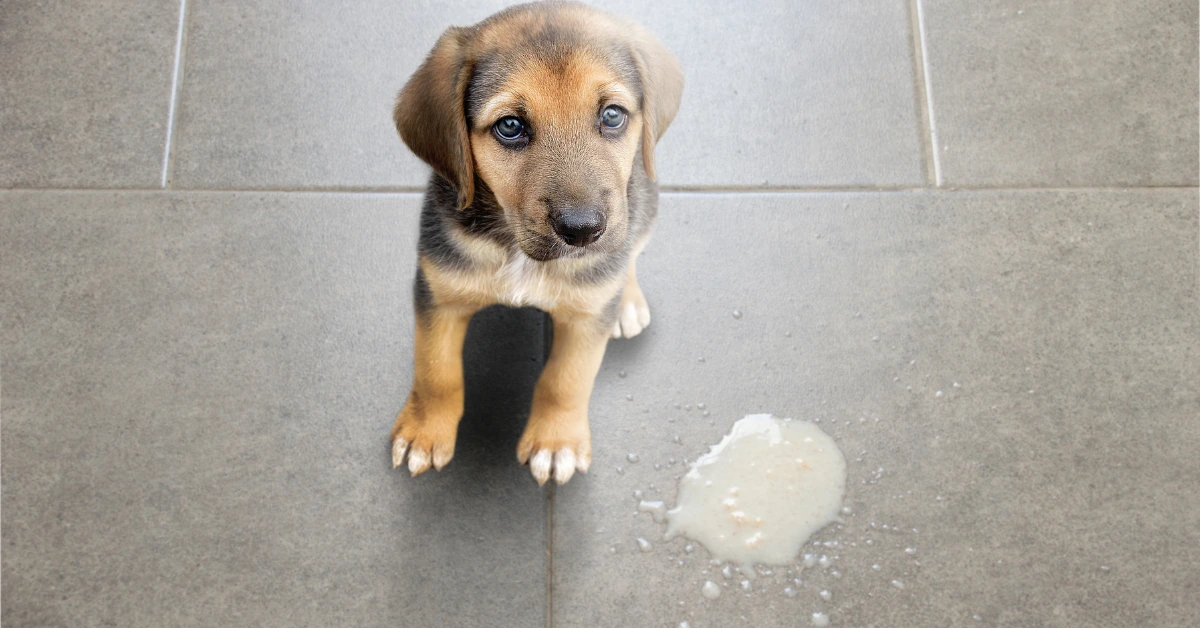Dog Throwing Up White Foam? Here’s What to Do
Imagine your dog suddenly hunches over and then vomits a thick, foamy substance. That white foam might make you feel just as sick. As a pet parent, seeing your furry friend in distress is heartbreaking.
Whether it’s a one-time thing or a recurring issue, knowing what to do next can help calm your nerves. This article will help you understand why your dog might be throwing up white foam and what to do about it.
Table of Content
Seeing your dog throw up white foam isn’t always a cause for alarm, but it’s never something to overlook. This guide will explore the possible reasons behind it and when you should act quickly. We’ll also share tips on how to care for your dog at home and when it’s time to see a vet.
Your dog’s health relies on making quick, informed decisions. Let’s get you ready to take the right steps.
Understanding Why Your Dog Is Throwing Up White Foam
When your dog vomits white foam, it’s often a sign their stomach is empty or irritated. This white foam vomit in dogs is made of saliva and a bit of stomach acid. Knowing why it happens starts with understanding the symptoms and behaviors.
What White Foam Vomit Actually Is
This foamy substance forms when your dog’s body tries to clear an empty or acidic stomach. It doesn’t have food particles and might mean nausea from eating too fast, stress, or minor digestive issues. Always note if it happens before or after meals.
Difference Between Vomiting and Regurgitation
- Vomiting: An active process with retching sounds, abdominal contractions, and fresh foam or food.
- Regurgitation: A passive release of undigested food from the esophagus, often occurring soon after eating.
Common vs. Concerning Symptoms
Occasional dog vomiting foam after play or stress might not need urgent care. But watch for:
- Repeated episodes within 24 hours
- Blood, yellow bile, or dark particles
- Lethargy, refusal to eat, or diarrhea
If symptoms persist or worsen, contact a vet promptly. Early recognition helps address underlying issues like dietary changes or gastrointestinal problems.
Common Causes of White Foam Vomit in Dogs
Dog vomiting white foam can come from simple issues or serious health problems. It’s important to look for other symptoms to figure out the cause. Here are some possible reasons:
- Empty stomach: If your dog hasn’t eaten for a while, bile and saliva mix, making white or yellow foam. This is common when they retch without vomiting food.
- Accidental eating: Dogs eating trash or harmful things might vomit white foam with bits of their meal. Look for diarrhea or tiredness too.
- Food allergies: Dogs with chronic vomiting white foam often have skin issues, ear infections, or loose stools. These symptoms last for days.
- Diet changes: Switching foods can upset a dog’s stomach. Watch for bloating or too much drooling with the foam.
- Gastritis: An inflamed stomach lining leads to repeated vomiting, which might include blood or dark stuff.
- Pancreatitis: Yellow foam with stomach pain, not wanting to eat, and feeling weak.
- Blockages: Vomiting white foam every day, a swollen belly, or no bowel movements.
- Organ issues: Liver or kidney problems might cause yellow foam, jaundice, or too much thirst.
Keep an eye out for other signs like changes in behavior or pain. If your dog keeps vomiting white foam or suddenly gets weak, see a vet right away.
When Dog Throwing Up White Foam Requires Veterinary Attention
If your dog is vomiting foam, knowing when to seek help is crucial. Some cases need quick action to avoid serious problems. Here’s how to spot urgent situations and know what to do.
Emergency Warning Signs
Call for emergency care right away if you notice these signs:
- Blood in vomit (looking like coffee grounds or bright red streaks)
- Repeated vomiting of foam within hours
- Dog coughing white foam with trouble breathing
- Severe tiredness, weakness, or not responding
- Abdominal swelling, stiffness, or not wanting to stand
Chronic Vomiting Foam Concerns
Recurring vomiting foam over days or weeks points to serious issues. Look for patterns in:
- How often and when it happens
- Changes in appetite or weight
- Other symptoms like diarrhea or losing weight
Conditions like kidney disease or inflammatory bowel disease may need special tests.
Puppies and Senior Dogs Need Extra Care
Young puppies lose fluids fast, making even mild vomiting foam risky. Puppies under six months might have birth defects or parasites. Senior dogs are at higher risk due to weaker organs. Chronic vomiting in seniors could hide diabetes, cancer, or organ failure. Always be cautious with these groups.
Home Care for a Dog Puking White Foam
If your dog is vomiting white foam but seems okay, you can try some home care. But, if they keep vomiting or it gets worse, get help right away. Safety first.
Immediate Steps to Take
First, take away all food and water for 12 hours. This lets their stomach rest. Keep track of how often they vomit and any other symptoms like tiredness or diarrhea.
Write down everything in a notebook for your vet. Don’t give any medicine without checking with your vet first.
Dietary Management
When you can, start feeding them again slowly. Here’s a simple plan:
- Start with boiled chicken (3 ounces) and cooked rice (2 ounces) for every 10 pounds of body weight. Feed twice a day.
- Go back to their regular food after 24 hours without vomiting.
- Use slow-feeder bowls to stop them from eating too fast.
Talk to your vet before making any big changes to their diet.
Hydration Strategies
It’s important to keep them hydrated. Encourage them to drink small amounts of water every 30 minutes. Try these ideas:
- Freeze electrolyte solution (like Pedialyte) into ice cubes.
- Check their skin elasticity: gently pinch the skin on their neck. If it doesn’t snap back, get help.
- Give them unflavored oral rehydration solutions that are safe for dogs.
If vomiting includes blood, lasts more than 24 hours, or they seem weak, stop home care. Always choose professional help for puppies, seniors, or dogs with health issues.
Preventing Your Dog from Vomiting Foam

To stop your dog from throwing up white foam, start with care before it happens. Making small changes in diet, environment, and routine can help a lot.
Dietary Adjustments:
- Stick to a consistent feeding schedule, avoiding irregular meal times.
- Choose premium dog food brands like Royal Canin or Blue Buffalo that match your dog’s age and breed needs.
- Use slow-feed bowls or puzzle toys to prevent overeating.
- Gradually transition foods over 7-10 days to avoid stomach upset.
| Tip | Benefit |
|---|---|
| Limit table scraps | Reduces exposure to harmful ingredients |
| Elevated feeding stations | Helps large breeds digest better |
| Hydrate before meals | Prevents bloating and foam formation |
Environment & Health Habits:
- Secure trash cans and toxic plants to block accidental ingestion.
- Reduce stress through calm routines and supervised play.
- Schedule annual vet visits for early health screenings.
- Use flea/tick preventatives and dental cleanings to address hidden health issues.
Keeping your dog’s exercise routine steady and avoiding sudden changes helps. Feeding them smaller, more frequent meals can also ease stomach pressure. Keep an eye out for signs of food allergies and talk to your vet if you notice any.
Conclusion: Supporting Your Dog’s Digestive Health
Understanding why your dog vomits foam is key. Sometimes, it’s just a minor upset stomach. But, if you see blood, lethargy, or constant vomiting, it’s serious. If your dog has pale gums or trouble breathing, get them to the vet fast.
For mild cases, try fasting and giving them water. But, if it keeps happening, see a vet. They can check for things like pancreatitis or stomach problems.
Keeping your dog’s digestive system healthy is important. Watch what they eat and make sure they don’t gobble their food. Regular vet visits help catch problems early. Remember, ignoring vomiting can lead to bigger issues.
Knowing about dog vomiting foam helps you make better choices. If you’re unsure, always talk to a vet. A mix of home care and vet advice keeps your dog healthy. This way, they can enjoy life with you.
FAQ
Why is my dog throwing up white foam?
Dogs may vomit white foam for many reasons. This includes an empty stomach, eating things they shouldn’t, or stomach problems. The foam is usually saliva and stomach acid. It happens when the stomach is upset or if your dog isn’t eating right.
How can I tell the difference between vomiting and regurgitation?
Vomiting is when your dog actively throws up, including white foam. Regurgitation is when food comes up without effort. Look at how hard your dog tries and if the vomit has bile or food.
When should I be concerned about my dog throwing up?
You should worry if your dog shows signs like being very tired, vomit with blood, or vomits a lot. Also, watch for diarrhea or vomiting that doesn’t stop. These could mean a serious problem.
What are common causes of my dog coughing up white foam?
Reasons include an empty stomach, sudden food changes, or food allergies. Gastrointestinal issues like gastritis are also common. Serious causes might include infections or organ problems, so watch for other symptoms too.
How can I help my dog if they’re puking white foam at home?
First, let your dog’s stomach settle by not feeding them for a bit. Keep track of how often they vomit and any other symptoms. After a short fast, start with small amounts of bland food.
Are some dogs more susceptible to vomiting foam than others?
Yes, some dogs are more at risk. Puppies and older dogs are often more vulnerable. Puppies can get dehydrated quickly, while older dogs may have health issues.
What are the hydration strategies if my dog is throwing up foam?
Encourage your dog to drink small amounts of water often. If they won’t drink, try ice cubes or flavored water. Watch for dehydration signs like dry gums or tiredness.
What dietary management tips can prevent white foam vomiting?
Feed your dog regularly with good quality food that fits their age and size. Slowly introduce new foods to avoid upset stomachs. Also, watch for food allergies that can cause vomiting.

